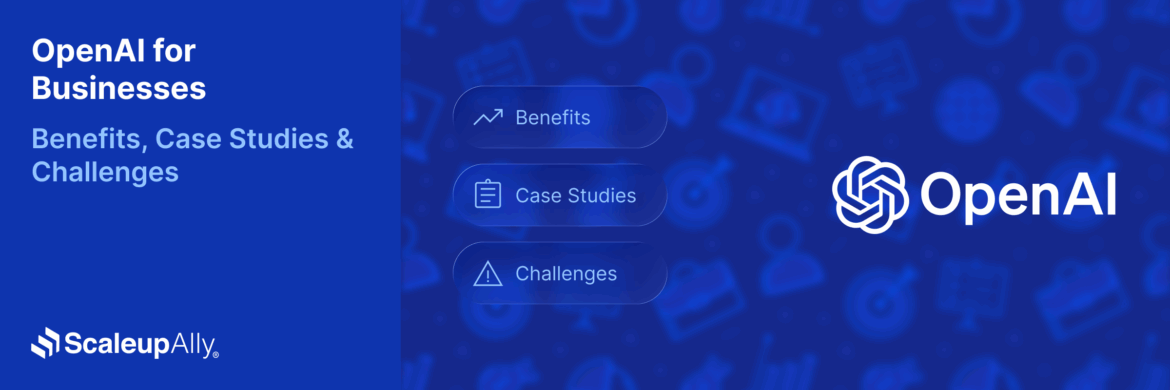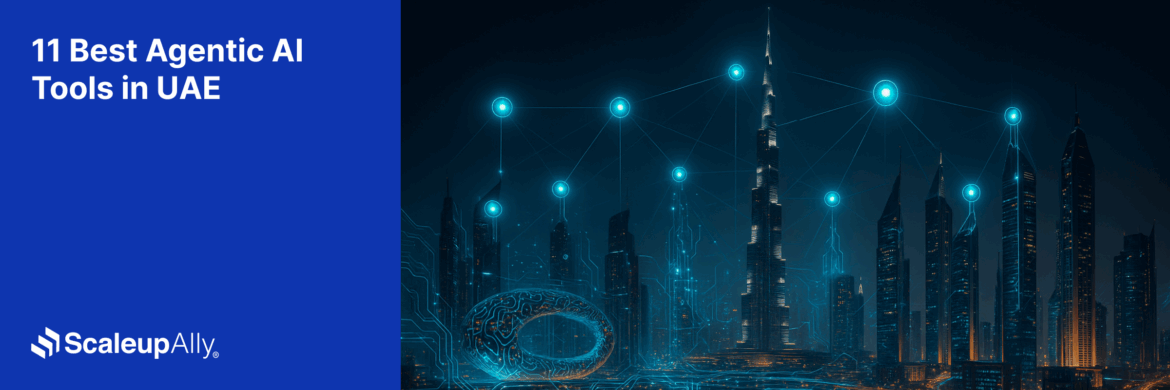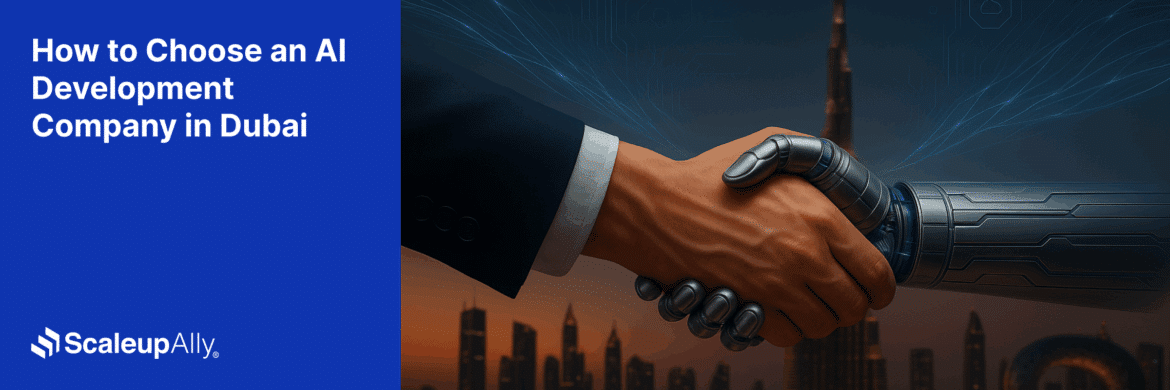
7 Limitations of AI You Need to Know Before Investing in it
ScaleupAlly Team | November 24, 2024 , 10 min read
Table Of Content
Everyday there are a lot of headlines talking about AI. With over 80% of companies integrating it to boost efficiency and stay competitive, the acceptance of the new normal is quite evident. Even Google has recently announced that 25% of their codes are being written by AI and validated by humans.
But as businesses race to harness AI, they often encounter challenges like bias, high costs, and unpredictable outcomes.
Understanding these limitations of AI is important when it comes to making smart investments.
7 Key Limitations of AI
Here are some key limitations of AI that businesses need to be aware of before investing:
1. Lack of Creativity
One of the biggest limitations of artificial intelligence is that it cannot think creatively as humans. Human uniqueness can not be replicated by AI, simply because in its current form, AI is growing with pattern recognition, and humans can recognize & think abstractly. AI is created to follow patterns based on training data, although there have been a lot of improvements, still AI cannot generate anything out of pure creativity. For example, AI can mix two music genres to create a new one, but it would never be able to generate a piece of new music without inspiration from another music.
This lack of creative ability and instinct is one of the key drawbacks of AI because it limits AI’s usefulness in fields that require innovation. AI performs best with tasks that follow clear rules, but it struggles with open-ended problem-solving.
2. High Costs of Implementation and Maintenance
A major limitation of AI for SMBs lies in its high development and maintenance costs. AI-powered systems demand advanced hardware, powerful servers, and vast amounts of data to function smoothly. Hence, hiring skilled tech professionals such as data scientists, engineers, and AI specialists further increases the expenses and empty’s the pocket.
In addition to this, AI models do not run without timely updates and need retraining to stay accurate. This becomes particularly costly when data shifts or changes, particularly in sectors like AI in e-commerce and healthcare, where algorithms must constantly adapt to changing trends.
This leads to the increased operational costs, and thus amounting to the limitation to AI development, which discourages smaller businesses with limited budgets. Before investing, companies must carefully prepare an AI development cost estimate to evaluate these expenses against the expected benefits.
Although using existing models such as OpenAI’s GPT or Google’s Gemini, SMBs can save on costs, but would not be able to completely personalize the outputs, or have to be dependent.
Also Read: The Cost to Build Generative AI
3. Biases and Context Limitations
As mentioned, AI generates output by following the patterns of data it is trained on. So, If the training dataset includes biases, such as gender, race, or socio-economic biases, the AI will replicate these in its output and further widen the biases gap.
Since AI lacks true comprehension, and operates only within the boundaries of its training, it may produce outputs without grasping their broader implications, which can be harmful in certain contexts.
For example, an AI recruiting tool trained on biased historical data could end up favoring male candidates over equally qualified female candidates, reinforcing existing inequalities.
These limitations of artificial intelligence make it difficult to ensure fair, unbiased decisions, especially in areas like hiring, lending, or law enforcement. AI also struggles with understanding the nuances and context of human behavior. It sees patterns in numbers, not the complex realities of social dynamics, limiting its ability to make ethical or socially responsible decisions.
4. Requires Constant Human Monitoring
Now, we know that AI can not think, instead it follows patterns and could be biased while getting work done. That means, it requires a lot of human intervention and/or monitoring to ensure the expected output. One of the AI limitations businesses often overlook is the need for human oversight to spot errors and handle exceptions. Even advanced algorithms can misinterpret data or produce incorrect outputs.
For example, an AI system used for financial fraud detection might incorrectly flag a legitimate transaction as suspicious, leading to inconvenience or loss of trust.
Similarly, AI limitations and challenges are evident in healthcare, where diagnostic AI tools must be monitored to prevent errors that could result in life-threatening situations. Human oversight is a must to ensure AI systems stay aligned with business goals and deliver reliable performance.
These Human oversight/monitoring jobs add additional costs and delays in quality output, which in some use cases can make the AI completely useless.
5. Limited Understanding of Wide or Long-Term Context
AI performs exceptionally well with specific, well-defined tasks but struggles when it comes to understanding broader contexts. Let me tell you this personally, “AI may fail to follow all the rules told by you, if you’ve provided multiple rules/tasks at the same time”.
This is another significant limitation of AI, especially in industries where long-term trends or nuanced insights do matter. AI can also ignore some of the context, if the length of context/tasks/rules is too lengthy.
6. Lack of Precision and Unpredictability
Another major drawback of Artificial Intelligence is the variability in its outputs. Although AI outputs are based on training data or fixed patterns, there is some randomness added to make things look more natural, which can create inconsistency in some areas.
Even with the same inputs, AI systems sometimes deliver inconsistent results due to this probabilistic nature. This lack of precision makes AI unreliable for tasks that require absolute consistency, such as medical procedures or financial transactions.
The unpredictability in AI systems highlights one of the limitations of artificial intelligence, it can’t always guarantee the same outcome every time. Making it rendered not so reliable in mission-critical operations, where even minor errors or deviations can have significant consequences. Businesses must factor in this variability and use AI cautiously in high-stakes scenarios.
PS: In very rare cases, AI can even generate completely inaccurate outputs out of nowhere, and correct output for the same input on the next try, which raises questions about AI’s reliability.
7. Lacks Emotions, Empathy, and Common Sense
AI might excel at tasks driven by logic and data, but it falls short when emotions or human intuition are involved. This limitation of AI becomes apparent in customer service, healthcare, and management roles, where understanding emotions and empathizing with humans is the need of the hour.
Since, Artificial intelligence lacks emotional intelligence and cannot make decisions that involve empathy or common sense, it is imperative for output errors.
For example, AI chatbots can answer customer queries but struggle to handle sensitive or emotionally charged conversations. Similarly, AI can’t manage social dynamics or make ethical judgments the way humans do. These AI limitations and challenges show that human emotional intelligence is irreplaceable.
How Can Businesses Mitigate AI’s Key Limitations?
AI has significant potential, but businesses need to navigate AI limitations to get the best out of it. Knowing what the limitations of AI are, like bias, lack of creativity, and unpredictability, is essential to using it effectively. Here are practical strategies to overcome these drawbacks of AI and maximize its impact.
1. Embrace Human-AI Collaboration
Rather than replacing humans, AI should complement human skills. AI excels at handling repetitive, data-heavy tasks, while humans bring creativity, empathy, and judgment to the table.
By assigning tasks strategically, businesses can create workflows that utilizes the strengths of both AI and human workers. This ensures limitations of artificial intelligence, like the lack of emotional intelligence, do not affect operations.
For example, an AI system might analyze data or summarize for humans, who will make decisions or plan businesses.
2. Continuous Learning and System Adaptation
AI models require constant updates to remain effective. Markets evolve, trends shift, and data changes, all of which can affect AI performance. Businesses should invest in regular retraining of their AI systems and monitor outcomes to spot any drop in accuracy. This addresses AI limitations like unpredictability and helps maintain the relevance of AI tools.
Additionally, monitoring AI output ensures the system adapts over time, preventing AI bias in decision making from negatively impacting outcomes.
3. Develop Clear Ethical Frameworks and Guidelines
AI raises ethical concerns, especially around bias, data privacy, and accountability. To mitigate these challenges, companies need well-defined ethical guidelines for AI development and deployment. Establishing frameworks ensures the responsible use of AI while minimizing risks like biased outputs.
These policies should cover data governance, transparency, and how AI decisions align with company values.
A robust framework not only mitigates drawbacks of AI but also builds trust among stakeholders by demonstrating responsible practices.
4. Monitor and Adjust AI Algorithms Regularly
AI systems are not infallible. Regular audits of algorithms and their outcomes help spot biases and inaccuracies early on. This ensures the system remains aligned with business goals while preventing AI limitations and challenges, like random outputs, from disrupting critical operations.
Businesses can also implement feedback loops, where humans review AI outputs, ensuring continuous improvement.
Maximizing AI’s Value by Addressing Its Limitations
AI offers transformative capabilities, but businesses must navigate its limitations thoughtfully to harness its full potential. By being proactive—embracing ethical practices, leveraging human-AI collaboration, and investing in continuous learning—companies can mitigate challenges like bias, unpredictability, and high costs.
When these limitations are addressed, AI can be a powerful tool for innovation, efficiency, and growth.
Leverage AI Ethically with ScaleupAlly
At ScaleupAlly, we enable businesses to create trustworthy Gen AI solutions by combining our deep expertise with cutting-edge models like OpenAI’s GPT and Google’s Gemini. Our team prioritizes smooth user interactions while addressing AI challenges like bias and unpredictability through robust ethical frameworks and reliable monitoring.
Whether you need intelligent chatbots or sophisticated AI tools, ScaleupAlly is here to support you in harnessing AI’s potential responsibly and effectively.
Ready to build ethical, reliable AI solutions? Connect with ScaleupAlly today!
Wrapping Up
AI is a powerful tool, but it’s not a magic bullet. Understanding its limitations is crucial for businesses looking to invest in AI. By using AI responsibly and strategically, businesses can leverage its power to achieve their goals while reducing potential risks.
The future of AI is bright, but it’s important to remember that AI is a tool, and like any tool, it needs to be used wisely.
Frequently Asked Questions (FAQs)
Q: What are the drawbacks of AI in business?
A: AI can be expensive, prone to biases, and require constant monitoring. It also lacks creativity, emotional intelligence, and common sense.
Q: What are the challenges of using AI in business?
A: Businesses need to address ethical concerns, ensure data privacy, and manage the integration of AI into existing systems. They also need to be prepared for the potential for job displacement and the need for ongoing training and development.
References
Author Spotlight
Diwakar Swami, Software Engineer
Related Blogs

OpenAI for Businesses [Benefits, Use Cases & Challenges]
Discover the benefits of OpenAI for businesses. From reducing costs to scaling operations and enriching customer experiences. Real-world use cases included.
ScaleupAlly Team
Dec 16 ,
11 min read

Best 11 Agentic AI Tools in UAE: Accelerating Digital Transformation
Discover the top 11 agentic AI tools in UAE for 2025. Explore features, benefits, and tips to choose the right AI tool for your business growth.
Manu Jain
Nov 6 ,
9 min read

How to Choose an AI Development Company in Dubai: A Complete Guide
Find out how to choose the right AI development company in Dubai. Learn key factors, local considerations, and tips to select the best partner.
Manu Jain
Nov 6 ,
9 min read


